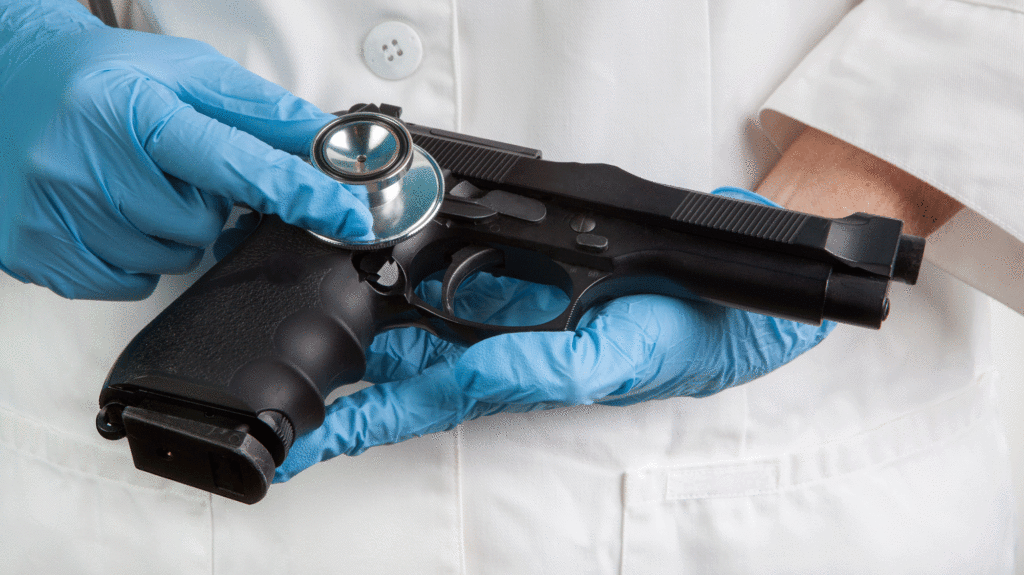[Ed: DRGO sees lots of “studies” marketed as gun control justification that we don’t have time to report on in detail, though they all should be. Thankfully, they often are reviewed by other Second Amendment advocates. We thought we’d catch up on a few here this week, some having been mentioned on our Facebook timeline, some not, but all worth attention (sometimes repeatedly). The next installment comes Thursday.]
“California’s comprehensive background check and misdemeanor violence prohibition policies and firearm mortality” by Daniel Webster, ScD, MPH, Garen Wintemute, MD, MPH, et al, in February’s Annals of Epidemiology. We love this one, because it is one of the few from either the Johns Hopkins School of Public Health (Webster) or UC-Davis (Wintemute) that is reasonably well designed, following changes in the same location over time (trend analysis) rather than comparing different locations at the same time (cross-sectional analysis). And they found that neither California’s comprehensive background checks (UBCs) nor it’s prohibition of misdemeanor violence conviction status for firearm purchases made any difference in the incidence of firearm homicides or suicides—i.e., in “gun violence”. They were left advocating for “permit to purchase”, naturally, an escalation of infringement rather than admitting that their “gun violence” solutions are not.
Pair this with January’s publication of DRGO member Dr. Mark Hamill’s group of “State Level Firearm Concealed-Carry Legislation and Rates of Homicide and Other Violent Crime” in the Journal of the American College of Surgeons. Here, in another quality study comparing the trends before and after changing concealed-carry laws in all states, they found no correlation between these laws’ restrictiveness and rates of violent crime, “there was no significant association between shifts from restrictive to nonrestrictive carry legislation on violent crime and public health indicators.” We know that UBCs, tightening prohibiting criteria, and freer concealed carry laws do not cause increased violence.
Advertisement — Continue Reading Below
Stir in confirmation by the CDC of Gary Kleck’s seminal work that there were easily over a million episodes of defensive gun uses (DGUs) each year during the 1990s (“Case Closed: Kleck is Still Correct”). That’s most of what we need to know to prove how valuable our responsibly armed citizenry is in keeping this country safe and more peaceful than not. That’s without even checking Dr. John Lott’s Crime Prevention Research Center, where the rest of the work has already been done, or GunFacts which keeps track of everything there is to know about it.
Ah, but according to the CDC: School Homicide Rate Up Dramatically from 2009 to 2018. Even if we buy their numbers, this was 514 victims in 431 incidents overall through 24 years, or about 21 people per year. Each one is tragic, yet as national emergencies go, is this? The CDC doesn’t track many causes of death with such little objective impact. We like to point out the more than 400,000 or more iatrogenic patient deaths each year that the health care professions are responsible for as meriting far greater attention from public-spirited doctors; this would be very much in their lane.
And we shouldn’t accept those numbers at face value. By dividing the types of killings into “single” and “multiple”, the authors are ignoring the standard historic FBI definition of “mass shootings”. That requires one or more perpetrators randomly shooting people unrelated to them in a public place, with at least 4 deaths not including the shooter(s). Their classification includes two or more fatalities, without reference to whom.
Advertisement — Continue Reading Below
There were only 30 “multiple-victim” incidents killing 90 children ages 5–18 years old. (The age range is realistic, and relieving, because too many refer to “youth” up to 24 years old.) Obviously, nearly all of the victims were actually killed in single murders, which were nearly all purposeful and personal.
These “school homicides” occurred not only on school property, but also when the victims were “traveling to or from” any school or school-sponsored event. It doesn’t clarify whether every attack had anything to do with these events. Media makes far more of fewer than 4 victims of these not necessarily “school shootings” each year than public policy should.
The CDC researchers’ statement in the study reveals the agency’s unabated agenda to promote “gun violence” regulatory intervention: “A comprehensive approach to violence prevention is needed to reduce risk for violence on and off school grounds.”
Advertisement — Continue Reading Below
CNN (of course) also reports that “Handguns are more popular in US homes, with deadly consequences for children” 1 to 5 years old. This refers to “Family Firearm Ownership and Firearm-Related Mortality Among Young Children: 1976–2016” published in Pediatrics in February. Now there is a good point made by the end of the article, that the intervention that counts is to ensure that unsupervised children cannot access our firearms. But the implication is that increasing numbers of handguns themselves (and not also increasing numbers of long guns?) are responsible. Besides that being nothing but correlation (≠ causation, remember), they are assuming that “changes in firearm ownership from predominantly rifles to handguns” has occurred. No one knows which class predominates, even though there are increasing sales of handguns.
“Child deaths from firearms [sic] . . . were on the decline until 2001” then have increased . . . “over the past decade from 0.36 per 100,000 children ages 1 to 4 to 0.63 per 100,000.” Now there were 80 deaths from all gun-related causes in the United States in the age group 1 to 4 years old in 2017. If we’re concerned about a 75% increase to 80, that means 46 deaths at baseline. Given the overall death rate of 25.3 per 100,000 for these ages in 2016, a change in such small numbers of .27 per 100,000 is not what we’d call a public health crisis—it’s a rounding error. (The point is valid even though years 2016 and 2017 were used here.)
.
Advertisement — Continue Reading Below
.

— DRGO Editor Robert B. Young, MD is a psychiatrist practicing in Pittsford, NY, an associate clinical professor at the University of Rochester School of Medicine, and a Distinguished Life Fellow of the American Psychiatric Association.
All DRGO articles by Robert B. Young, MD
Advertisement — Continue Reading Below















